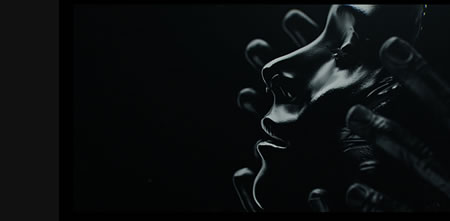
Logos, fonts, custom alphabets and design strategies: from one sheet to main titles
WORKING AS A DESIGNER IN
THE THEATRICAL BRANDING
Design / Strategy market, the “instinctually” founded process is pebbled with uncertainty and the foibles of a largely intuitive and gut-based iterative idea-evolving process.
Logos mean a lot — it’s how people read titles, get the opening draft of the spirit of the holistic story, and it can carry them along, in the revelation of the campaign — from start to finish — including, in a well orchestrated campaign to theatrical / film marketing,
But, to planning, it’s rarely an entirely linear form of “thinking” –it’s more about a perpetual string of sparked inspirations and insights, ever evolving.
That likely stems from the holistic process as to how movies are made, which are wholly idea-based — and ultimately, how those outcomes are marketed. Intriguingly, it’s rare that a film has a red “design thinking” threading from the opening story [its design], to film production[its design] to film marketing[its design]. Instead, it’s a fractured uncovering and reassembly, to arrive at the final [re]turns to the market.
Except here: [http://trailers.apple.com/trailers/iphone/sony_pictures/thegirlwiththedragontattoo/trailer/]
For Dragon, noted above, the line of query isn’t so much about the whole story, front to back — since the original Steig Larsson books were well-packaged as an international branding effort, in their marketing. To me, in the second cinematic treatment, holistically art-directed by David Fincher — it’s the bridging from teaser trailer to one sheets and main titling. What isn’t an idea-based business, one might ask?
THE IDEA TEAMS OF FILMMAKING
Movies are made of a complexity of idea teams — first, the story might be conceived or positioned; it’s written once — potentially as a book, then a screen play is rendered. A script is drawn up, then “the package” is offered for options — these negotiations, every step thus far is managed by various handlers and deal wranglers — processes are built to make the film with a village of talent, sometimes invoking hundreds of people.
The geography of production is an incredibly complex landscape of talented idea-contributors — filming begins with a close partnering of production [experience / set / staging design – “what’s the world of the story going to look like” and casting “who’s going to be in the film to support the telling of the story.” Cinematographers — “what’s the light, the filmic character as to how the film will be lensed? — formulating the translation “from idea to filmed, projected presentation” — each of these personalities provide leadership to teams; and, at the apex of this talent pyramid is the director, the top ideator, the visionary “what is this story going to be, holistically?” that oversees every detail — clarifies and coalesces the imaginings of many to the channeling of many technologies to one story. It is the labyrinth of this formidable cadre of talent that the process is invariably fluent — ideas flow, story experiments evolve, shooting ideas emigrate and the core detailing of the marketing of the film is one of shifting and ebbing, side to side, flow to flow, tidal emotional surging and trends in motion picture marketing and production continue to influence each other. Launch dates are set, showreels are shown to theatre owners, premises are expressed — holistic stories / movie packages are bought and sold. More ideas in post — additional tunings, editing, actual “recorded,” environmentally “active” sound design [and music as a disparate storytelling deepening] are added to layering of holistic presence, storytelling — and brand — are collated into the promise of entertainment.
Theatrical marketing — from compelling teasers and trailers to one sheet posters and print, as well as the big picture of print, transit, subway, billboards and the dizzying array of interactive postings, catapulting online games, mobile links, audience updates, challenges, production galleries and subscriptions, tweets and expressions in progress. Opening ideas for core visual strategy are argued — photoshoots, imagery, art, copywriting and integrated plans — some are tested, to audience focus studies, along with trailers and movie test snippets, reactions are studied, and the movie — at that late stage, to be reconfigured.
Dragon — round two, with Fincher’s efforts, seem more coalesced, refined and directed. Working with him on Benjamin [ https://www.girvin.com/blog/?p=2009 ], the same thinking held true. We started with study, building, research that was about environment, coupled with typographic design patterning — to get there, to identity integrations — that [ https://www.girvin.com/portfolio/identity/benjaminbutton/benjamin.php ] spread from titling, fonts and identity to holism of marketing implementations. Fonts, as design language can vibrate [https://www.girvin.com/blog/?p=3570] the cult of the filmic intentionality.
For Dragon, studying the progressions from print to titling — main titles, you can see that, the song remains the same, the vibe rings true. Nasty, dark, black liquid emotionality — brutal, a hammering: http://www.youtube.com/watch?v=Ax1myOC2-Ho&feature=youtube_gdata_player
Watch the titling, above. And the trailer: [http://trailers.apple.com/trailers/iphone/sony_pictures/thegirlwiththedragontattoo/trailer/] — the teasing “micro storytelling of the brand,” the film. One-sheet styling, at the top of the blog — note the custom font for the titling, and the logo, linking the glue of the thematics, together. While they are not all, precisely the same, they synchronize vibe and holistic feeling.
Typographic styling, like the reading of any text — lends impression to holism in marketing.
The melody is there, the song remains the same.
TSG
…..
G I R V I N | DESIGNING MOVIES
THEATRICAL BRANDING + ENTERTAINMENT
IMAGINATION: AND THE TOOLS TO MAKE IT HAPPEN
http://bit.ly/seAMZf